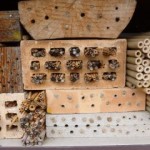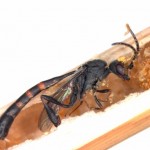To bee or not to bee
Pollinators such as bees provide vital ecosystem services. Without insects, many plants could not exchange pollen, and their seed set would be reduced. Bumble bees and honey bees are most people’s favourites; but in fact there are a much greater variety of solitary bees in the world. Some of these insects can be easily attracted to your garden by offering nesting opportunities. These can either be a bundle of reeds or a log with holes drilled in and they can be simple or rather more elaborate, like the one pictured here from the Botanic Gardens, Zurich. In fact, it’s not just bees that will use a nest site like this, many wasp species will also take advantage of a safe, dry home. But have no fear; these wasps won’t sting; just clear your garden of unwelcome caterpillar and aphid pests.
Food for thought
The readiness of wild species to take advantage of these nesting opportunities, and the range of species available, make these nests ideal study units for ecologists. Standardised nests can be constructed and put out at different locations and after some period they can be collected in and examined. The numbers of species and the interactions within the nest can then be quantified and related to the habitat characteristics. They have been used to great effect to quantify, for example, the importance of wild-flower strips in agricultural landscapes. The interactions come about because, as always in nature, nothing is left alone to just get on with its life. Many of the bees and wasps become targets for parasitic species that either parasitise the food store, leaving the host with nothing, or worse, lay their eggs inside the host’s body and eat it from within.
How green is your garden?
We used these nests to assess the quality of family gardens (known as allotments in the UK) throughout the city of Zurich. The work was carried out by two dedicated Master’s students: Sarah Pelkoffer and Katherine Horgan. In the first year of the study Sarah put out these nests in 32 different gardens at 16 different sites. The sites differ in their size, greenness and other characteristics. The following year Katie identified all the species and is currently constructing food webs for each nest. We’re hoping to finish analysing this data soon, so watch this space to find out which gardens have the most species, and the most intricate patterns of interactions.


